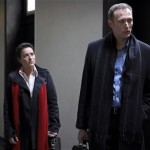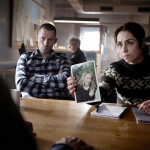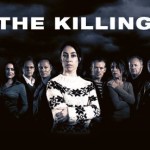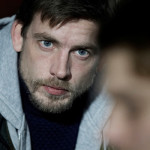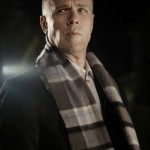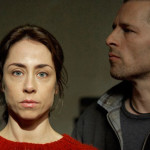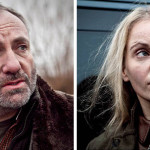Regular readers will know I am not keen on dramas or movies being remade into English, particularly American. Quite apart from the tendency to gild the lily, the translations and the culture are not the same, so going back to the original foreign language versions can often prove a total revelation. Neither do I always take to police/crime dramas, as much for their ubiquity as much as anything; choose any given day and look at the TV schedules and you’ll probably find three or four police procedurals.
Question then is whether watching police series based on another land and a different perspective on life will pique my interest. Fact is that there is now a keen following of Scandinavian dramas, other examples including Borgen and Wallander among others. They may have a reputation for being dour, understated and humourless, so you might be justified in asking what appeal there might be. I’ve been watching two such series:
- “Forbrydelsen” actually means “the crime” in Danish, though the principle crimes in The Killing (as translated into English and retained for the US remake, which I have yet to see) boil down to murder, surprise surprise.
- The Bridge is a joint Swedish/Danish coproduction; like The Killing it proved very popular and sparked an American remake that I have yet to see (based on the so-called Crystal Frontier between the USA and Mexico); like The Killing it is a police procedural drama, though in style they are radically different.
So far as these two dramas go, I hereby join the fanbase of the originals on the strength having seen two series’ worth of each. But what is it about them that I was gripped throughout by each and could barely put either down?
The answer is that they are typically more cerebral, contain more rounded characters and pack a punch in ways that stand out from the regular diet gained from – purely through a different cultural context and mindset. Of course, they are stamped with personality and cues in the way that any series has its own internal rule set. After all, you would be right to say that this is no different in that it has its branding, characters and cues, much as 24 depends on the ticking clock motif and the Kiefer Sutherland tough-but-tender look as he doggedly pursues the criminals alone – this being but one example among thousands of stylistic design cues.
The Killing
The Killing is an intense, complex, detailed criminal study. At the helm here is Søren Sveistrup, and what is notable in Sveistrup’s brand is the cold and precise weaving of parallel storylines all pertaining to the central murder plot. In series one we have the police investigation, headed up by Sarah Lund, of whom more anon; we have the family of the victim and the conflicts caused by the death of a beloved daughter, Nanna Birk Larsen, and subsequent revelations about her life; and we have the race for the mayoral election, in which Troels Hartmann takes on wily veteran incumbent Poul Bremer.
In this narrative, leads, accusations and twists come thick and fast, and the pace never lets up over 20 episodes, which reminds me of the equally gripping Murder One, series 1 – except that, in the Scandinavian style, characters are more reflective and less likely to give away secrets. One look from bereaved dad Theis Birk Larsen (Bjarne Henriksen) tells a thousand words – or maybe causes us to leap to entirely the wrong conclusions, who knows?
No-one is more phlegmatic than the new deputy police chief Lennard Brix (Morten Suurballe), certainly not a character to mouth off without good reason. Most of the recurring characters have depth and substance not commonly found in TV programmes, though ironically very little is revealed about Brix outside of the force.
You could not say the same about Lund (Sofie Gråbøl) and Hartmann (Lars Mikkelsen, so deliciously villainous in House of Cards and Sherlock), around whose rollercoaster fortunes series 1 revolves. Gråbøl became a Scandinavian legend for her choice of knitwear in The Killing, not a feature repeated in the American remake, but it is the character’s personality that makes her such compelling viewing – on which more shortly.
Perhaps the greatest strength of the series is that it makes full and effective use of bittersweet ambiguity, and even in resolutions some victories remain decidedly pyrrhic and come at often severe cost. Oh, and the attention to detail, such that every nuance of interpretation in every morsel of evidence and behaviour is analysed and taken to its logical extreme, alone and in conjunction with every other known fact.
Often this results in the police going off half-cock to interview or arrest suspects – and to be fair, the are complex murders in which the identity of the actual murderer is hidden behind a shoal of red herrings and contributory actions. Long gone are the days when a villain merely held up his hands and yelled, “It’s a fair cop, guv, you’ve got me bang to rights!”
The Bridge
The Bridge (Bron/Broen) was the brainchild of Swedish writer/director/actor Hans Rosenfeldt, and a neat idea it was too: a serial killer places a body right across the Danish/Swedish border in the middle of the Øresund bridge linking Copenhagen and Malmö, which body turns out to be in two halves from different corpses one Danish and the other Swedish, thus forcing the Danish and Swedish police to work together.
That these forces are represented on the investigation by chalk-and-cheese homicide officers Martin Rohde (Kim Bodnia) – who has five children by three different women, with twins on the way after his vasectomy and whose weak-willed attitude to marriage forms a major thread of the story – and Saga Norén (Sofia Helin) – highly intelligent and capable, dedicated to her work but socially dysfunctional – provides the dynamic and many of the quirks in the cat and mouse chase in series 1. Rather than jumpers, Norén’s renowned characteristic is the vintage Porsche 911 she drives, which the actress Hellin apparently hated with a passion (of which more to follow.)
That series reminded me strongly of a Scandinavian twist on the David Fincher movie Se7en – though whether that was an influence is not clear. The parallels are self-evident: a serial killer with a hidden agenda has spent years planning a pattern of murders staged to make a specific political and moral point; the police are struggling to catch up and get inside the mind of the killer, anticipate his next moves, pick up suspects, protect the innocent… But the police do not discover the true motive until the killer chooses to reveal it and stages the finale in which, like Se7en, his ultimate goal is to be shot dead by the police.
I won’t give any further spoilers, but safe to say this is a more conventional plot line, and less encumbered than The Killing with the minutae of every scrap of evidence, with interpretation of every word spoken by each witness in search of insight – but it is no less compelling drama. The two protagonists hurtle backwards and forwards between Denmark and Sweden as events pile upon one another in both jurisdictions. In fact, one weakness of The Bridge is that you totally lose track of where they are at any one time. Here’s a contrast though: where Se7en is dark and bleak and The Killing often dark, The Bridge is cast with a greenish tinge and is a tad jauntier in outlook.
We pick up on the back stories of other characters too, both in the respective police forces and those who end up as victims or witnesses in one way or another. One such is a homeless man, played by none other than Morten Suurballe who played Brix in The Killing, whose life is threatened by being bled to death while streaming live on the Internet, but who still manages to communicate to the police.
An early player is a journalist, Daniel Ferbé (Christian Hillborg), a journalist who acts as a mouthpiece for the killer but ultimately a victim of the ingenuity and apparently unlimited expertise (watch out for nifty rewiring of Ferbé’s car, for example.) In spite of having a more conventional storyline, The Bridge is endlessly inventive, but ultimately focuses on the importance of Rohde’s family while Norén grapples to understand the emotional complexities therein.
Series 2 is slightly different, in that some of the villains are featured up front, though inevitably the narrative weaves in twists and turns, just as you would expect.
Lund vs Norén
Given to occasional startling and dramatic insights, Lund is unquestionably gifted but headstrong and wilful – her tendency to pursue her train of thought in defiance of orders and sometimes with disastrous consequences leads her into conflicts with her bosses and, apparently, senior politicians.
One interesting fact is that the impish and ultimately tragic Martin Rohde remains the Norén sidekick for two series before throwing in the towel and being replaced, while Lund gets through one a series – for reasons I won’t explain here. Where Rohde is an old school police officer, not afraid of a few short cuts and the odd knockabout laugh with his partner, Sarah’s sidekicks in series 1 (Jan Meyer played by Søren Malling) and 2 (Ulrick Strange, played by Mikael Birkkjær) are much sharper and edgier, with conflicts guaranteed.
Sarah Lund is prickly and more of a loner, even though she is perfectly capable of communicating with her family – they just take second place in her affections. Lund is undeniably courageous and dedicated to a fault, even to the extent of losing her Swedish boyfriend after she repeatedly fails to move to her new job with the Swedish police in order to complete the case in Copenhagen. She flirts will romance in series 2 (no more clues, sorry!), but ultimately is deflected by her single-minded determination to build a case and put the perpetrator to justice – often against considerable odds (the conclusion of series 2 springs to mind.)
Norén shares Lund’s insight and perspicacity, though not her car crash of a private life – by virtue of having no history of relationships. Her idea of intimacy is picking up strange men in bars for transactional sex, at a loss to understand emotions in others. In series 2 she briefly has a man move in with her, but her desire to be good at relationships results not in more open communication but getting out of bed in the early hours to read psychology tomes on the subject! Norén’s equivalent of Lund’s iconic sweaters is her car: a 1977 Porsche 911 in a deeply unattractive olive green. It goes everywhere with her and tells you all you need to know about her.
Thanks to Rohde, Saga learns to tell white lies, all the better to persuade witnesses to talk. In fact, her tendency to speak the truth bluntly and inappropriately – and to lack any form of empathy whatever, let alone irony – is most probably due to unspoken Asperger’s syndrome. While Norén’s apparent autistic tendency is the constant elephant in the room, it earned Helin much fame for being virtually unique as a female character on the autistic spectrum (see here.) In fact, series 2 sees the education of Saga continuing as she attempts to learn how other people think and feel – without ever truly winning the battle.
Which of them would come out on top in a head-to-head crime solving battle? Probably Saga, since Sarah Lund will make many mistakes along the way. It’s not that Norén doesn’t screw things up along the way, but she tends to figure out the reality without too many false starts along the way – which makes Sarah far and away the more credible and realistic detective of the two.
The Verdict
There is no doubt in my mind that these are two eminently watchable and gripping narratives, though several friends have told me they prefer The Bridge, possibly because it is simpler and more direct. Having said that, series 1 of The Killing extends to 20 episodes compared to 10 for The Bridge and series 2 of The Killing, so inevitably it will throw up more twists and turns.
No doubt at all that you have to concentrate hard with both series of The Killing, but it is very rewarding when you do, for the true identity of the actual murderer (as opposed to the people who have contributed by misdeeds along the way) is not revealed until very near the end. The perpetrator in The Bridge is revealed earlier, though of the two it is the friskier and more impishly entertaining. Take your pick!
Question is though, do I watch the US remakes of either series? I’m sure both will be brilliantly made and acted, but I am positive that I’d almost certainly end up disappointed with the comparison – precisely because they will apply the conventions of US drama along the way. There are exceptions to every rule, though the American House of Cards was a different beast entirely than the jovial and minimal British adaptation of the books. In this case I will stick with Lund and Norén, simply because these are so closely tied in with the Scandinavian terroir – and good luck to them both!


